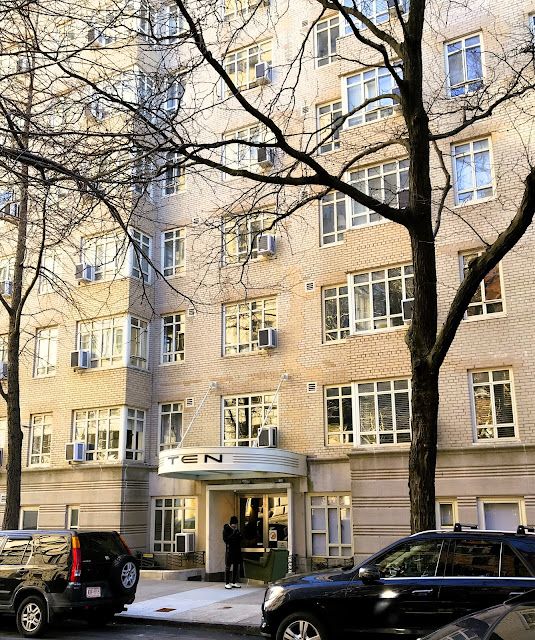The family of wealthy clothier Simon Banner had lived in the high-stooped, brick-and-brownstone house at 10 West 74th Street as early as 1893. Like their neighbors, the Banners maintained a household staff, a summer residence, and entertained graciously for decades.
Not long after this photograph was taken, the Banner house and its neighbors were demolished. image via the NYC Dept of Records & Information Services.
In 1940 Haven Properties, Inc. demolished the Banner house and three of its neighbors to make way for a modern apartment building designed by H. Herbert Lilien. Completed the following year, its clean Art Moderne design featured a striated stone base, multi-paned casement windows (some of which wrapped the corners), and a dramatic curved marquee that announced the address.
A 1941 real estate brochure pictured the new building. from the collection of the Columbia University Libraries.
There were eight apartments per floor in the 10-story building. The real estate brochure boasted:
Magnificent, excellently furnished lobby...glass enclosed tubs and showers thru-out...roof sun deck for use of all tenants...master radio aerial...mail chute on every floor...extra large rooms and dropped living rooms thru-out.
Potential residents could choose suites from two to four rooms, "renting from $900 to $1400 per year and up," according to The New York Sun on September 4, 1941. The smallest apartments, said the article, "include a dropped living room, dining foyer, small bedroom and kitchenette complete in every respect even to its quota of kitchen cabinets."
A typical floorplan was shown in the 1941 brochure. from the collection of Columbia University Libraries.
Among the initial residents were professionals like loan broker Robert Wiess, a 1937 graduate of Michigan State University. Charles Banks and his wife lived here in 1946 when they announced the engagement of their daughter Peggy to Lieutenant Harold A. Weiss of the U.S. Navy Reserves. She was a graduate of the private Fieldston School and the University of Iowa.
The Second World War had apparently delayed the couple's wedding plans. On February 25, 1946, The Daily Argus reported, "Lieutenant Weiss is stationed with the Headquarters of the Third Naval District in New York after completing 22 months of duty in the Caribbean." The war had also interrupted the young man's intended career path. He had graduated from the University of Alabama and Cornell University's School of Law.
The financial comfort of the residents was reflected in the East Hampton Star's announcing on June 12, 1952, "Dr. Edwin C. Rowe...of 10 West 74th St., New York, has rented the Emerson Taber camp on the west side of Three Mile Harbor for the summer."
Living here around the same time was Morris Fisher and his wife, the former Lucy Schwartz. Born in Rumania, he had come to America in 1907 and co-founded the Fisher-Beer Stores--a chain of variety department stores--in 1919. By 1956 the firm operated ten stores. The Fishers' social status was reflected in Morris's memberships in the Fresh Meadow Country Club and the Carlton Club.
Resident William T. Clemons came up with an idea for a television quiz show in 1957. Called The Hidden Treasure Show, it was scheduled to debut on April 5 on local stations throughout the country. Home viewers were invited to enter the "musical quiz" by sending in $1. Clemons and the promoters kept 15 cents, with the remainder going to the Disabled American Veterans. The premise sounded legitimate to almost everyone but Steven H. Scheuer, the writer of the "TV Keynotes" column in the Yonkers, New York Herald Statesman.
Scheuer saw the show as "a way to beat our laws" and make Clemons and his promoters millionaires overnight. He wrote an open letter to George McConnaughey, chairman of the Federal Communications Commission, saying in part, "Does the U. S. Post Office realize that if only five million people enter this telethon, the 'house cut' can exceed a half million bucks?" He ended his letter, saying, "Mr. Chairman, if you intend to sanction this 'enterprise', why not ask Uncle Sam to run a legitimate TV lottery and divert to proceeds to some worthy charity like balancing the budget?"
The third quarter of the 20th century saw a cacophony of windows and the loss of the splendid marquee. image via landmarkwest.org
At the time of Steven H. Scheuer's indignant rant, H. Herbert Lilien's stylish Art Moderne design had been badly treated. Replacement windows resulted in a mish-mash of conflicting configurations, and the building's hallmark marquee had been removed.
many thanks to reader Lowell Cochran for suggesting this post
photographs by the author
no permission to reuse the content of this blog has been granted to LaptrinhX.com







No comments:
Post a Comment